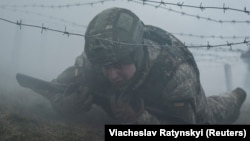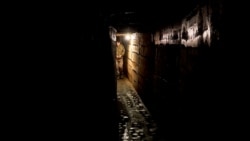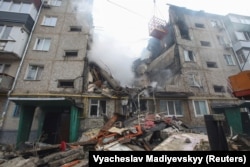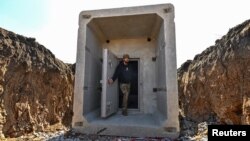The Russians are advancing. The Ukrainians are digging.
Weeks after notching their biggest battlefield win in nearly a year, the capture of the industrial city of Avdiyivka, Russian forces are advancing -- in some places, slowly, in other places, quickly.
Ukrainian commanders are rushing to lay out defensive lines -- trenches, bunkers, "hedgehog" tank obstacles, dragon's teeth, mine fields -- defenses some experts say should have been built months ago. Military recruiters and logistics officers, meanwhile, are scrambling to find more men to replenish decimated and exhausted units.
The situation on the battlefield is grim for Ukraine, experts say, and the disruption of weaponry and supplies from the United States is making it grimmer. Russia has the momentum and nothing in the foreseeable future is likely to change that, according to military analysts.
"The situation for Ukrainian forces remains very difficult, marked by a multitude of factors such as delayed mobilization efforts, insufficient fortification construction, missteps during the 2023 campaign, and notably, a critical failure of partners to deliver promised ammunition despite previous commitments," according to a Ukrainian reserve officer who oversees an open-source intelligence organization with ties to the Ukrainian military and cannot speak publicly due to military restrictions.
"It's quite bad actually," said Konrad Muzyka, a Polish-based defense analyst who visited several locations in Ukraine near the front lines last week.
"The Ukrainians are absolutely in no position to significantly degrade Russian forward momentum," he told RFE/RL. "The Russians will slowly but steadily capture new villages and settlements. It definitely will not be blitzkrieg. But I think it's fair to say that…currently the Ukrainians are at the weakest, probably since mid-2022."
The Fall Of Avdiyivka
In one aspect of the Russian invasion, Ukraine has had extraordinary success: in the Black Sea.
On the battlefield, it's a different story.
Ukraine's highwater mark on the battlefield came in the waning months of 2022 with the recapture of the Kharkiv region in the northeast and the Kherson region, on the west bank of the Dnieper River, in the south.
For much of last year, guided by Western advisers, Western trainers, and Western intelligence, Ukrainian commanders prioritized building a new force structure that would spearhead a counteroffensive against Russian troops. Nine new brigades were trained and equipped with NATO weaponry; another five to eight other brigades were also organized by Ukrainian commanders, outfitted with Western weapons.
Ukrainian forces launched their offensive last June on the order of General Valeriy Zaluzhniy, the country's top military officer at the time, pushing forward in three places along the roughly 1,200-kilometer front line.
It didn't go well.
Russia's defenses -- dubbed the Surovikin Lines after the Russian general credited for ordering their creation -- proved far more formidable and sophisticated than Ukrainian commanders had anticipated. After advancing short distances and capturing a handful of villages, Ukrainian units bogged down in places like Robotyne, south of the city of Orikhiv.
By year's end, with the onset of winter, Ukrainian troops were stalemated, as Zaluzhniy suggested in a contentious article published in The Economist.
Last October, meanwhile, in Avdiyivka, home to what was once Ukraine's largest coking factory, Russian forces began their own push to take the heavily fortified city to keep Ukrainian forces for threatening the regional capital of Donetsk, less than 20 kilometers to the south. That initial effort, a pincer effort to encircle Ukrainian forces, failed.
By January, Russian forces had regrouped and over the following weeks, with heavy use of aircraft and powerful weapons like glide bombs, and utilizing underground tunnels, troops put Ukrainian units -- the 110th Separate Mechanized Brigade was one of the main units that held the city -- in untenable positions.
Elite units, including the 3rd Separate Assault Brigade, were dispatched to help hold Ukrainian lines, but by February 17 Ukrainian commanders announced the city was lost and pulled their forces out.
Some Western media reports say the withdrawal was chaotic and disorganized, and scores of Ukrainian soldiers may have been taken prisoner.
'The Year Without Building Defense Lines'
Since Avdiyivka's fall, Russian forces have pushed westward, moving rapidly in the days that followed but, more recently, slowing.
Experts point to Ukrainian defenses getting organized and Russian forces relying heavily on infantry attacks due to large armor losses in the capture of Avdiyivka; some estimates say Russia lost more than 600 pieces of heavy equipment -- tanks, armored personnel carriers, infantry transports -- and thousands of personnel.
"So far the enemy in unable to push through defensive lines in the Avdiyivka direction," Maksym Zhorin, deputy commander of Ukraine's 3rd Assault Brigade, said on March 6. "But they're constantly trying advance, and where possible trying to advance at least just a little. Most of all, now they are rubbing against the settlement of Orlivka. Here, [Russian troops] are suffering simply huge losses but still continue to storm both day and night."
As of March 12, open-source data showed Orlivka, which lies northwest of Avdiyivka, had been overrun by Russian forces.
Russian forces are also pressuring Ukrainian lines at Robotyne, in the Zaporizhzhya region; near Kupyansk, on the eastern edge of the Kharkiv region; and west of Bakhmut, another Donetsk region city that was reduced to rubble before Russian troops, with major casualties, captured it in May 2023,
'Stabilize The Front Line'
About a week prior to Avdiyivka's fall, Ukraine's top command was roiled when President Volodymyr Zelenskiy dismissed Zaluzhniy. He was replaced with the head of the country's ground forces, Colonel General Oleksandyr Syrskiy. Syrskiy ultimately gave the order to withdraw.
Syrskiy's replacement as ground forces commander, Lieutenant General Oleksandr Pavlyuk, last week suggested Ukrainian forces might be able to stage another offensive this coming year.
"Our task is to stabilize the front line, to destroy as much as possible, which we are doing, and to regroup as much as possible to withdraw the units that already need to be replenished and restored on the training ground, in order to create a strike group and conduct counterattacks this year," Pavlyuk said during a government-sponsored TV broadcast.
It's an open question whether a new counteroffensive will be possible. That's especially true as authorities rush to build defensive lines that critics say should have been built months ago.
Last November, as Russian forces pressured Avdiyivka, Zelenskiy announced that a series of new fortifications and defense would be built to the west of the city and in other locations.
"On all main fronts, we need to dig in, we need to speed up the pace of construction," Zelenskiy said on November 30.
"Ukraine does not have good secondary lines, it doesn't have something like the Surovikin Lines the Russians built last year," said Michael Kofman, another veteran military analyst at Carnegie Endowment for International Peace. "In fact, Ukraine is quite behind on effectively entrenching across the front."
Russian forces may have momentum, Kofman said, but they also may find small areas where they're able to gradually poke through Ukrainian lines.
"It's potentially a slippery slope where you get like a death by a thousand cuts or essentially death by a thousand localized offensives," he said in a War On The Rocks podcast broadcast on February 24.
"Why was 2023 the year without building defense lines?" asked Ivan Stupak, an analyst with the Ukrainian Institute for the Future, a Kyiv think tank. "Because in 2022, we were excited, we were inspired by our victories…so no need to dig in. It was a mistake, and now we have to do it in emergency mode. And in some places, on the front lines, our soldiers are digging these trenches under fire."
"Who are we trying to fool, if there are no lines of engineering fortifications where our forces and equipment are?" Vladyslav Seleznyov, a military commentator and former Ukrainian military spokesman, told RFE/RL's Donbas.Realities. "In fact, our soldiers have become hostages to illegal decisions, or the absence of any decisions regarding the creation of those defensive lines and positions."
"This sort of work should've started six months ago," Muzyka said. The Ukrainians "might find themselves in a situation when the Russians will start attacking fortifications where they haven't been finished at all….They're far behind schedule in building."
Where Are The Guns?
The other major headwind Ukrainian forces face is the spigot of U.S. and Western weaponry, which, due to election-year infighting in Washington, D.C., is now all but shut off.
Whereas before Ukrainian troops were able to mostly match the rate of artillery fire from Russian forces, now the ratio is a heavily in Russia's favor: at least five-to-one and, by some estimates, as much as 10-to-1.
U.S. officials on March 12 announced they had scraped together $300 million for a new weapons package that includes anti-aircraft missiles, 155-mm artillery rounds, longer-range ammunition for HIMARS systems, and cluster munitions.
Still, CIA Director Willliam Burns told a Senate hearing on March 11 that Ukraine would lose "significant ground" without new U.S. equipment and weaponry.
He said Ukraine could likely "hold its own" through 2024 into early next year, but beyond that was doubtful.
"Without a surge in Western military aid and major changes to Kyiv's strategy, Ukraine's battlefield position will continue to worsen until it reaches a tipping point, possibly by this summer," said Dara Massicot, an expert on Russia's military and a senior fellow at the Carnegie Endowment for International Peace.
"On the present course, in which Ukrainian ammunition and manpower needs are not met, Ukrainian units are likely to hollow out, making Russian breakthroughs a distinct possibility," Massicot wrote in Foreign Affairs.

















